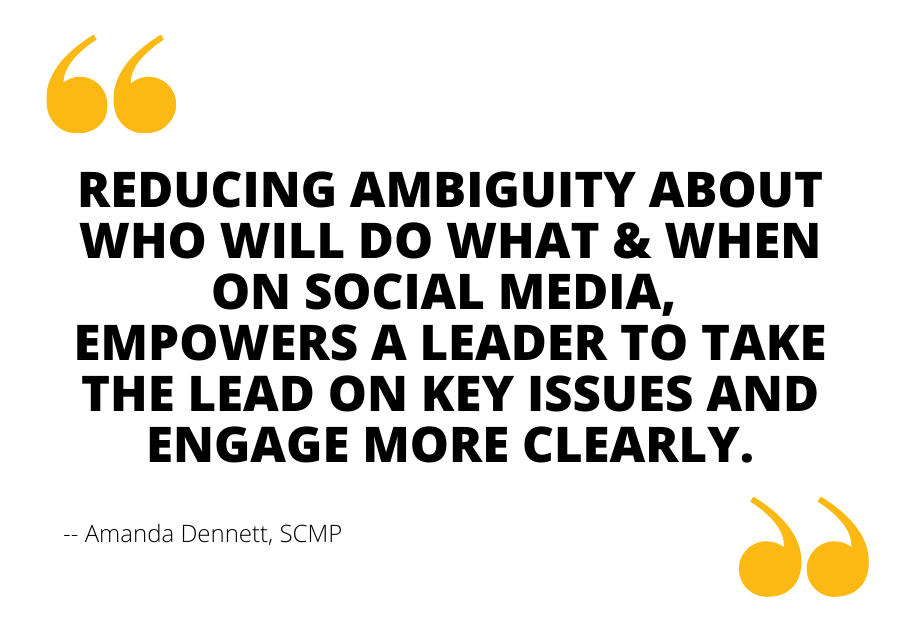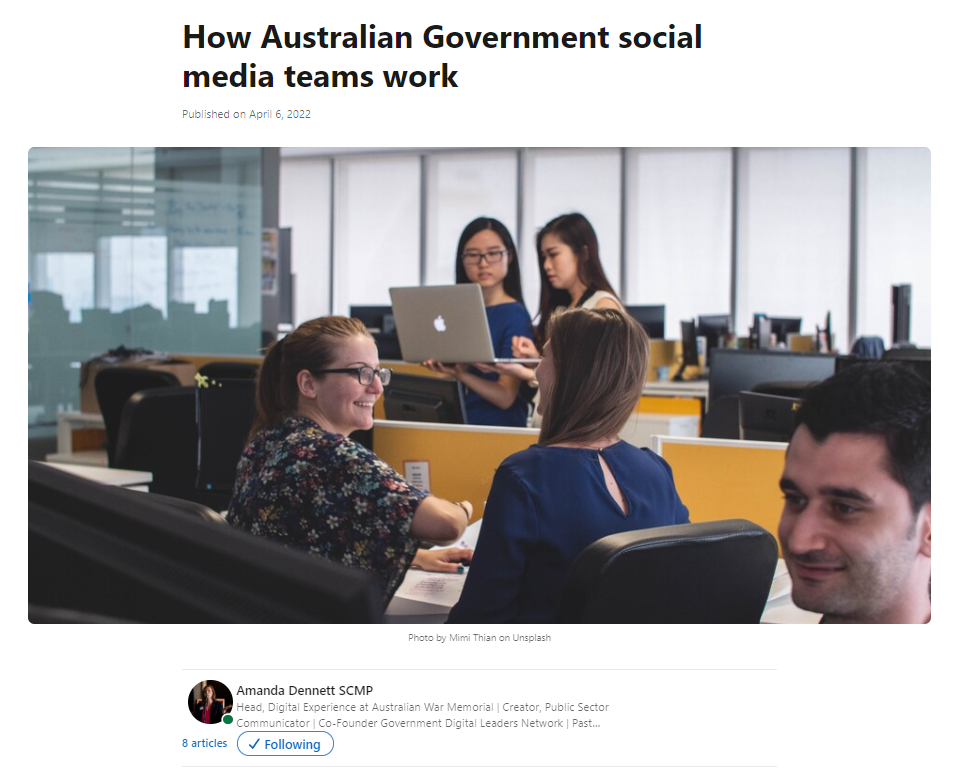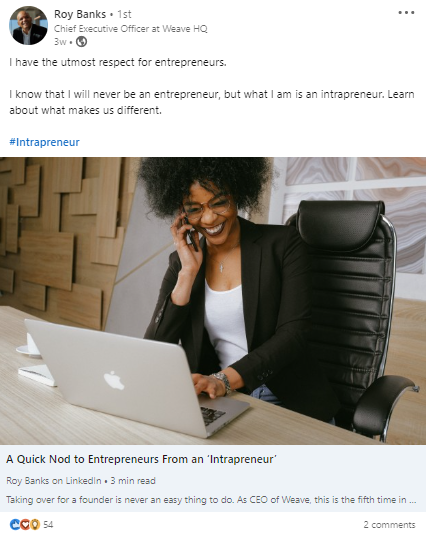When it comes to leaders on social media, it can be daunting to get started.
Getting started online is daunting for both the comms team and the leaders themselves. As the saying goes, the first step is always the hardest. And we’ve got reason for this. For almost two decades now, leaders across the public and private sector have been fed a seemingly endless stream of sensational social media horror story after horror story by mainstream media who seemingly find the success stories and people getting it right far less interesting. So instead of the benefits of leaders embracing social media, all they read about are epic leadership fails, employee activism and trolling. When you look at it that way, communication certainly seems simpler and reputation far more controllable before social media came along.
So with that as a backdrop, how can you make a compelling case for leaders on social media; to take the plunge and get onboard themselves? How do you draw their attention away from the risks to show it is, in fact, a huge opportunity? In this episode, we’re joined by someone who knows that challenge and how to succeed all too well.
Having been at the forefront of government social media in Australia for over a decade now, she was instrumental in the then Department of Human Services first forays into social media at both the brand and leadership level, and she has been a key industry figure in the broader digital communications landscape. As Co- Founder of the Government Digital Leaders Network, and past president of Canberra’s IABC chapter – and one of the loveliest people you’ll ever meet – it’s a privilege to have Government Communicator & Social Media Researcher, Amanda Dennett, SCMP share her top tips for how you can help leaders get started on social media.
I encourage you to take a listen to our conversation. Together we explore:
- The importance of tailoring support to a leaders’ comfort level, experience and digital goals.
- Key steps for building leadership trust, comfort and confidence online.
- How existing media management policies can help you get leadership social media buy-in.
- Best practice operations of public sector social media teams today.
Here’s a snapshot from our chat.
The advice + insights.
Roger Christie: In your perspective, how do you help leaders take their first steps online?
Amanda Dennett: I think for communication professionals, when supporting any leader to jump into social media to build their online brand and your organisation’s reputation – the first thing I do is ask the leader, “what help do you need”. Because the people that you’re working with are going to really vary in terms of their experience using social media, their comfort level, and their understanding and experience of communication strategy.
In practice, I’ve had to help leaders come up with a whole strategy for how they use social media and education around that – right down to the practical details of how to get the Twitter app on their phone, logging in and helping them work out who to work out who to follow. What does it mean to kind of favourite something? Who to retweet and who not to retweet? So really, that question of “what help do they need” is so specific to the individual that you’re going to be supporting. So I think start off with this question and ascertain their comfort level and what they are hoping to achieve – and then tailor your social media support to match.
Roger Christie: The online world looked dramatically different when you worked for Centrelink back in 2010 than it does today. How did you sell social media to your superiors back then?
Amanda Dennett: At the time, the Department of Human Services (now Services Australia) and the Australian Taxation Office were the two key departments starting to use social media to share messages. And like others, we really did begin with broadcast – emulating some of the media messaging for social media. To sell that in, it was really talking to leadership about this new opportunity – that there was a growing audience that we needed to, at a minimum, listen to and understand what was being said. I really tried to align that with the Department’s existing media management approach, which was media monitoring. They were comfortable with wanting to know what was being said about them in the media. Being able to expand on this existing policy into social media made that much easier.
Similarly, the organisation had quite a strong talkback radio strategy and relationships. Our General Manager and Spokesperson for Centrelink issues, Hank Jongen, would go on talkback radio and answer people’s questions about their payments and services, and address difficult questions upfront. So again, it was saying to leadership that this model will work online as well, with some tweaks. We need to be there to hear people. It’s the new talkback radio, essentially.
Roger Christie: What was in your toolkit to build trust for continued investment in and from Hank Jongen and other senior figures?
Amanda Dennett: It required a fair bit of planning from a team perspective. And I do encourage people to still do that homework. Today, we’re much more comfortable with social media because we use it ourselves as part of our own social lives. So there’s an inherent understanding as comms professionals about how those channels work. But it doesn’t mean you shouldn’t do your homework in terms of what preparation and support you need to provide to leaders who are going to jump into this space?
Reducing ambiguity about who will do what and when on social media, empowers a leader to take the running on key issues and engage more clearly. I don’t think anyone in this day and age expects the head of an organisation to respond to all queries online. We know that they’re really busy people addressing and leading all sorts of big issues. So it is entirely appropriate to have two streams running simultaneously. Understand what key issues your spokesperson or leader will address online, and what will the team address.

You can support leaders with their social media engagement by providing them with similar tools and support you would give them for a media interview. For example, if an organisation is going to make an announcement that is shared on social media, equip your leader with some background materials and talking points on that issue so they’re across it and not surprised by queries on social media. That’s what we would do for a media interview. So again, it translates to social media also.
Roger Christie: You’ve actually spent a fair bit of time researching what makes social media teams successful in recent years. How important is leadership participation to that overall social media success?
Amanda Dennett: I have spent a couple of years researching social media and best practice operations of social media teams in the Australian public service. I looked at case studies from the Australian Taxation Office and Department of Human Services, along with a survey that I ran of public sector social media workers to find out about team processes, operations and how they are operating at best practice today.
Some the findings were really interesting around the importance of leadership on the success, or perhaps non-success of social media teams. And it was really clear in conversations with some of the case study interview participants that there was executive support for their social media work – that really has to be one of the success factors that we can attribute to the Department of Human Services and ATO. There is a comfort level amongst their executive about engaging with social media, a recognition that it is a key source of information about potential issues that help the agency to identify early and potentially fix.
Click here to listen to Amanda’s conversation in full.
Learn more about Amanda’s social media research findings here.
Amanda’s 5 tips to helping leaders get started on social media.
Ask the leader upfront, “what help do you need”: Ascertain their comfort level and what they are hoping to achieve – and then tailor your social media support to match.
No matter how comfortable you on social media, do your homework: Know what preparation and support you need to provide your leaders at every stage before they jump into this space.
Understand the key issues your spokesperson or leader will address online.
Reduce ambiguity about who will do what and when to empower leaders to take the lead on key issues and engage more clearly.
Support leaders with their social media engagement by providing them with similar tools and support you would give them for a media interview.

Ask the leader upfront, “what help do you need”: Ascertain their comfort level and what they are hoping to achieve – and then tailor your social media support to match.

No matter how comfortable you on social media, do your homework: Know what preparation and support you need to provide your leaders at every stage before they jump into this space.

Understand the key issues your spokesperson or leader will address online.

Reduce ambiguity about who will do what and when to empower leaders to take the lead on key issues and engage more clearly.

Support leaders with their social media engagement by providing them with similar tools and support you would give them for a media interview.
Digital leadership in practice.
In addition to the leaders at the ATO and Department of Human Services, if you’re looking for additional examples of leaders newly harnessing the power of social media, CEO of Weave HQ, Roy Banks is great one. His article in Forbes maps his journey from passive to purposeful online participation, and what he’s learnt about his stakeholders and himself along the way. From embracing transparency, to supporting social issues and authentically talking about the things that matter to him, Roy demonstrates what intentional content creation and engagement can do for your digital reputation.
Final takeaway.
When it comes to starting out, leaders would simply benefit from some personal reflection on what their level of comfort with engagement is. And that is going to vary for everyone. And it’s okay that it varies. Some people are going to want to weigh in on social issues more heavily. They feel confident to do that and it’s something they probably do in their personal lives as well. They’ve got a level of comfort doing that in a professional setting while remaining apolitical – if they’re a public sector employee – or making sure that it doesn’t bring their organisation into disrepute if they’re a private sector employee. If you’re someone who doesn’t do that by nature, and doesn’t want to stand out or put your head up too much on social media, that is ok and that’s valid. Especially when you’re starting out, it’s okay to pare things back a little bit. When helping leaders on social media, particularly when they are just starting out, knowing and respecting their personal limits is really important.To listen to this conversation in full, head to Apple Podcasts, Spotify or wherever you get your podcasts.
Please subscribe, leave a review or drop Roger Christie a note with any thoughts from this conversation – we’d love to hear from you.



